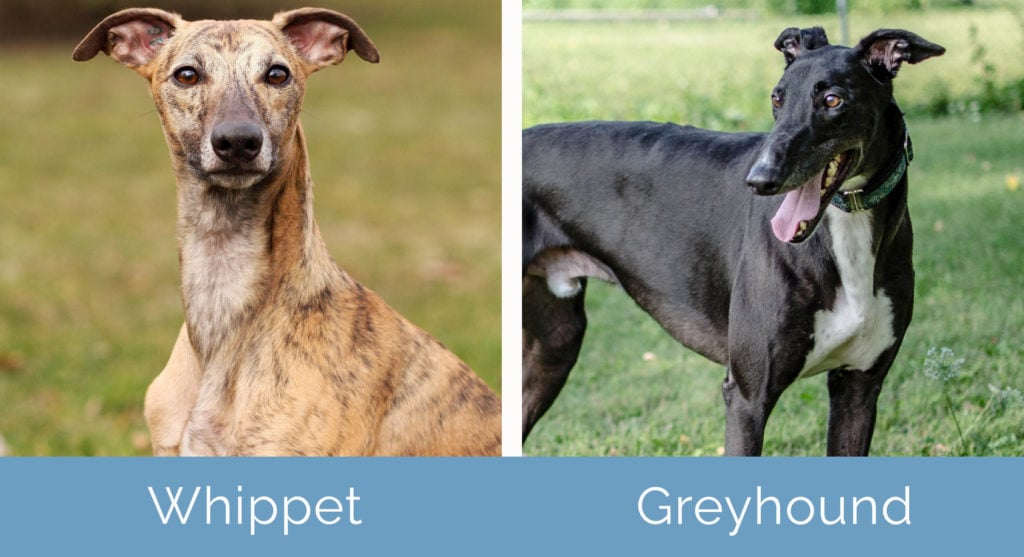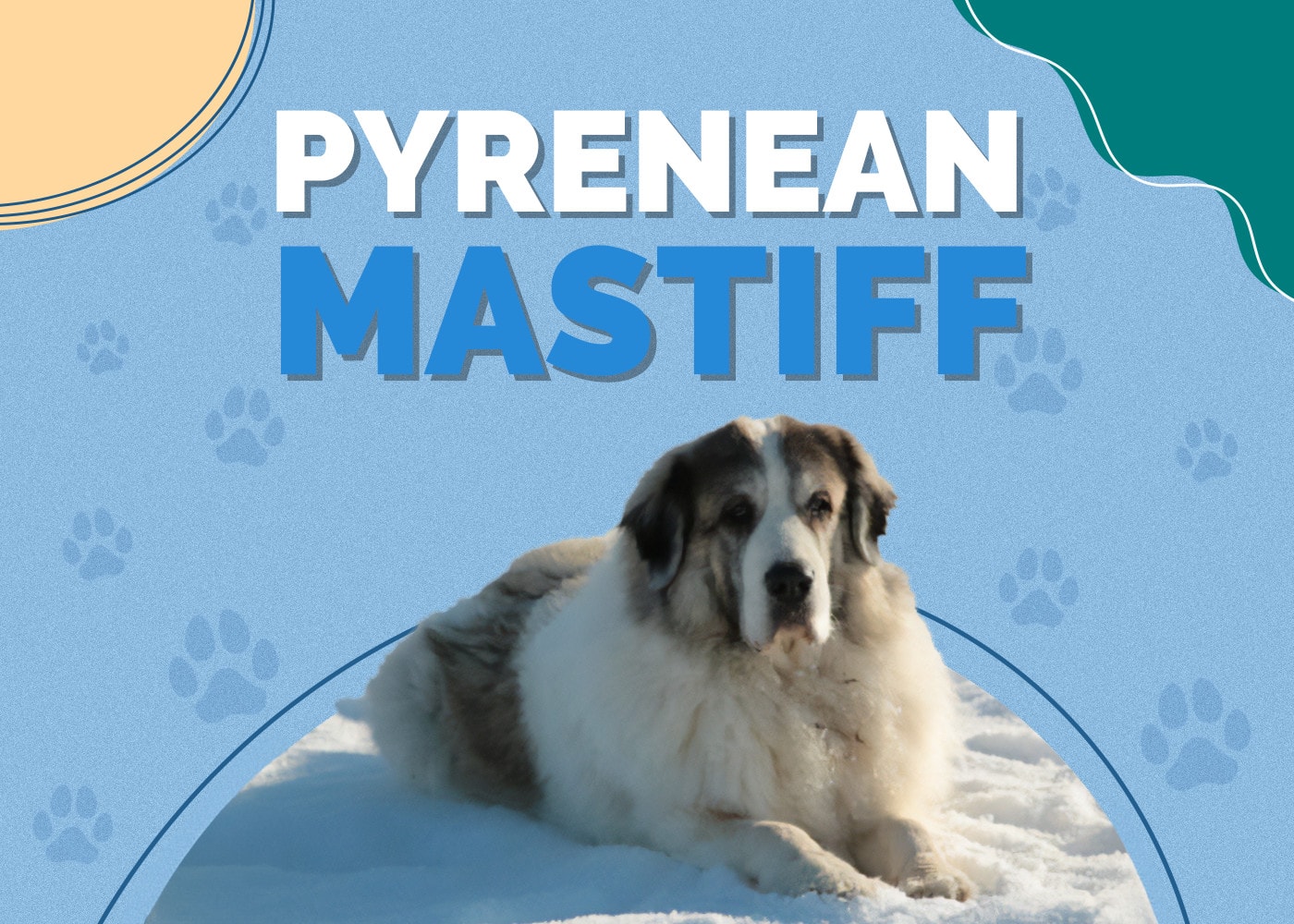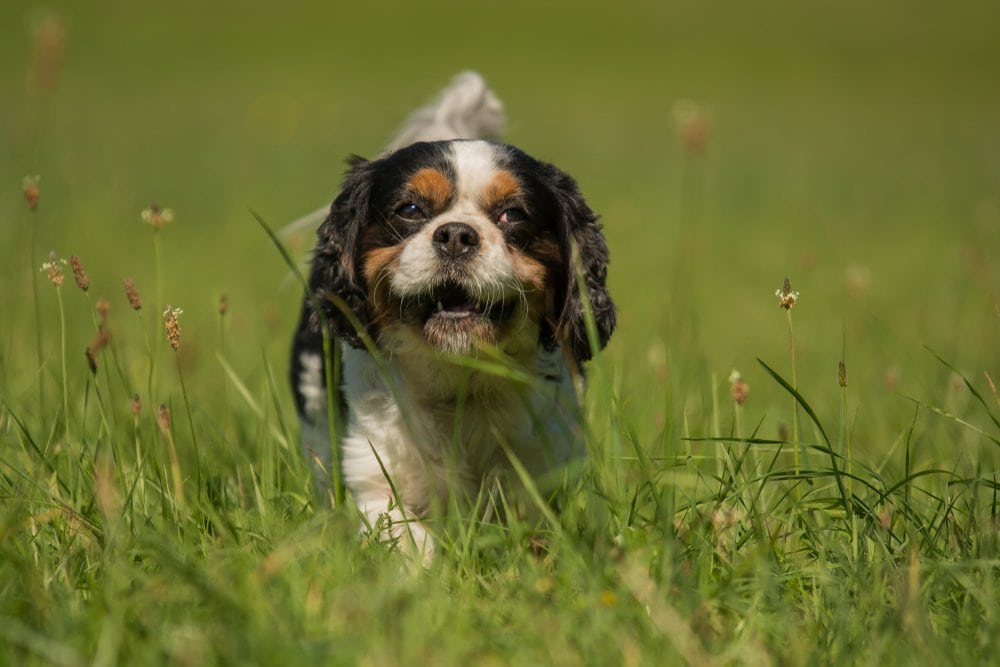Whippet vs. Greyhound: What Are the Differences?

Updated on
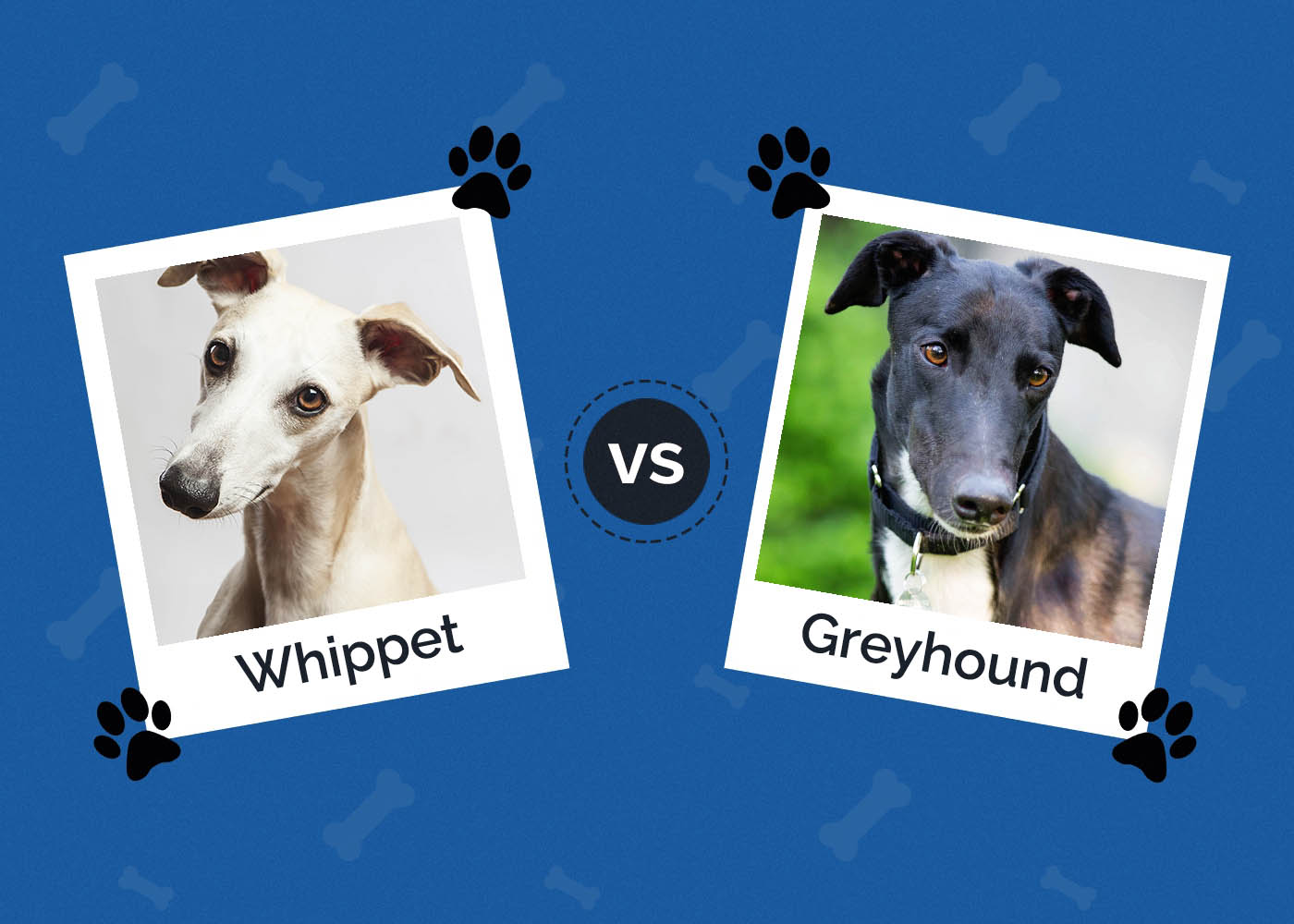
When it comes to cases of mistaken identity in the dog world, there are no other breeds more commonly confused than the Greyhound and the Whippet. Even seasoned professionals have difficulty telling them apart at younger ages.
Both dogs belong to a group of breeds known as sighthounds. Sighthounds are long, slender hounds that use their explosive power and lean frames to race for small prey or for sport. These are among the fastest dog breeds on earth, with the Greyhound taking the top spot. A Greyhound can reach speeds up to 40-45 miles per hour in a quick sprint, and the Whippet tops out at 35 mph.
Either way, there are some clear and discernable differences between these pups. Let’s take a look at each breed individually and see how they compare.
Visual Differences
A Quick Overview
- Average Height (adult): 18-22 inches
- Average Weight (adult): 25-40 pounds
- Lifespan: 12-15 years
- Exercise: 45 min – 1 hour per day
- Grooming needs: Low maintenance, easy to groom
- Family-friendly: Yes
- Dog-friendly: Yes
- Trainability: Stubborn, often difficult to train
- Average Height (adult): 28-30 inches
- Average Weight (adult): 60-70 pounds
- Lifespan: 10-13
- Exercise: 1.5+ hours per day
- Grooming needs: Low maintenance, easy to groom
- Family-friendly: Yes
- Dog-friendly: Yes
- Trainability: Stubborn, often difficult to train
Whippet Overview
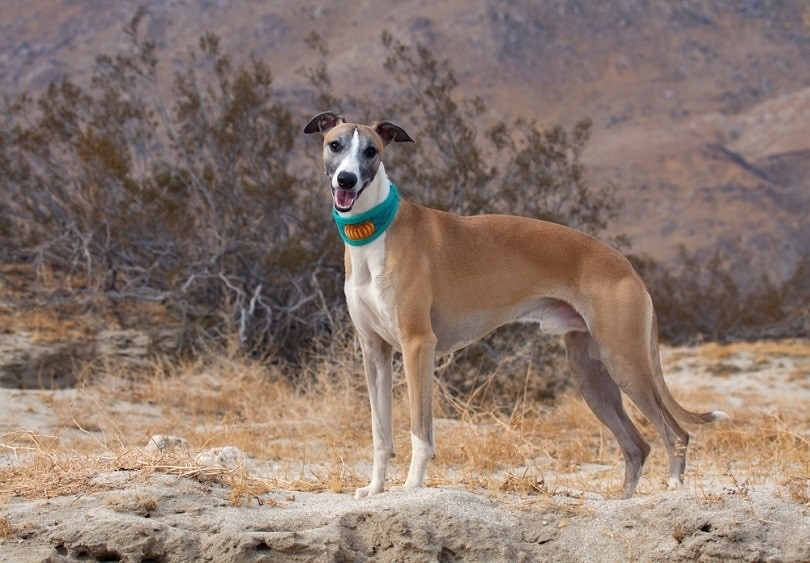
There’s no question as to why the Whippet looks so much like the Greyhound. And that’s because they’re directly descended from them. While the Whippet is several hundred years old as a breed, they are relative babies when compared to the ancient DNA of the Greyhound.
The Whippet was first produced by crossbreeding Greyhounds with long-legged Terriers of the 18th century. They originated out of Northern England where they were used to hunt small game such as rabbit.
Like the Greyhound, the Whippet also experienced some recognition as a racing dog, even earning the moniker of “the poor man’s racehorse.” Whippets were used to race to see which was fastest or even which could hunt down the most vermin.
Personality
Although Whippets are known for their speed and racing abilities, they’re not as active as you’d think. They only need roughly 10 miles worth of exercise each week, which is pretty chill for a dog of their reputation. There’s nothing they love more than finding themselves a nice spot on the sofa and curling up into a tight little ball.
Whippets are also excellent family dogs. They’ve got a gentle, quiet temperament that lends well to them being with kids, and they don’t bark too much either. So, when something’s seriously wrong, you’ll know. They make excellent guard dogs in that respect. But if you’ve socialized them properly, there’s a good chance they’ll treat an intruder as an old chum.
However, they do have a relatively high prey drive, which doesn’t bode well if you have a cat. It’s not that they’ll eat Fluffy, but leave them alone together for an extended time and you can bet your Whippet will terrorize the heck out of your kitty.
Training
Whippets are very smart dogs, but that doesn’t mean they love to listen. They can be quite stubborn and independent at times. They just like doing things their way. That’s why we don’t recommend them for first-time dog owners with zero puppy training experience. If you are looking for a Whippet as your first pooch, we strongly recommend a formal obedience school where both of you can learn how to strengthen your relationship and training regimen.
Like most independent dogs, training should start as soon as possible with frequent socialization. Without proper training, they’re known to be aloof to new people and strangers. And it may take some time before they properly warm up to them.
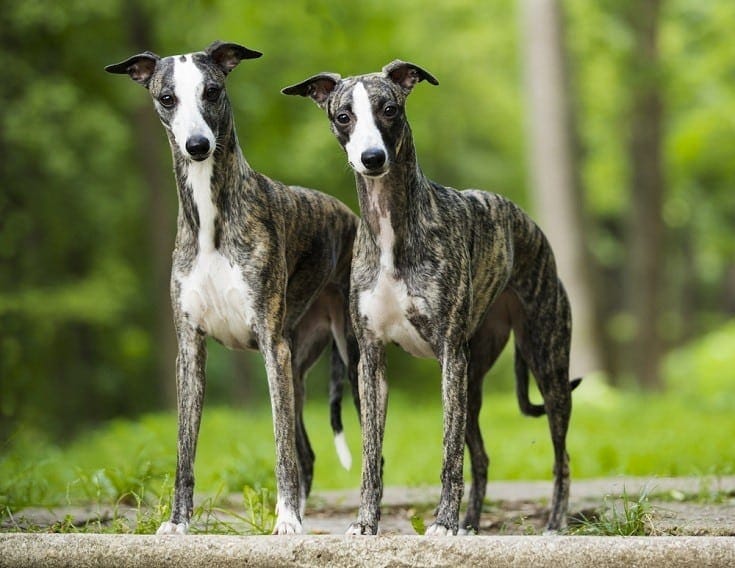
Health and Care
The lean frame and thin coat of the Whippet are very streamlined and beautiful. But these two elements make up the reasons why they experience many of their health issues. The Whippet commonly goes through joint health issues because their joints just aren’t built to carry heavy strains. Sure, they’re exceptionally fast; however, Whippets only move like that in short bursts. Sustained activity at that level does irreparable damage.
And their thin coats don’t provide much in the way of protection. They can easily get too cold in the winter and will require an extra layer to keep them warm throughout the winter. Also, you may notice your Whippet coming inside with extra scratches across their bodies. That’s because they don’t have the coat needed to fend off minor scratches from play or running around.
Fortunately, they are exceedingly easy to groom. They only require brushing around once or twice a month and a good washing only when it’s needed. The biggest grooming maintenance you’ll need to keep up with for these pups is their nails and teeth. Be sure to trim their nails twice a month and brush their teeth thrice a week.
Greyhound Overview
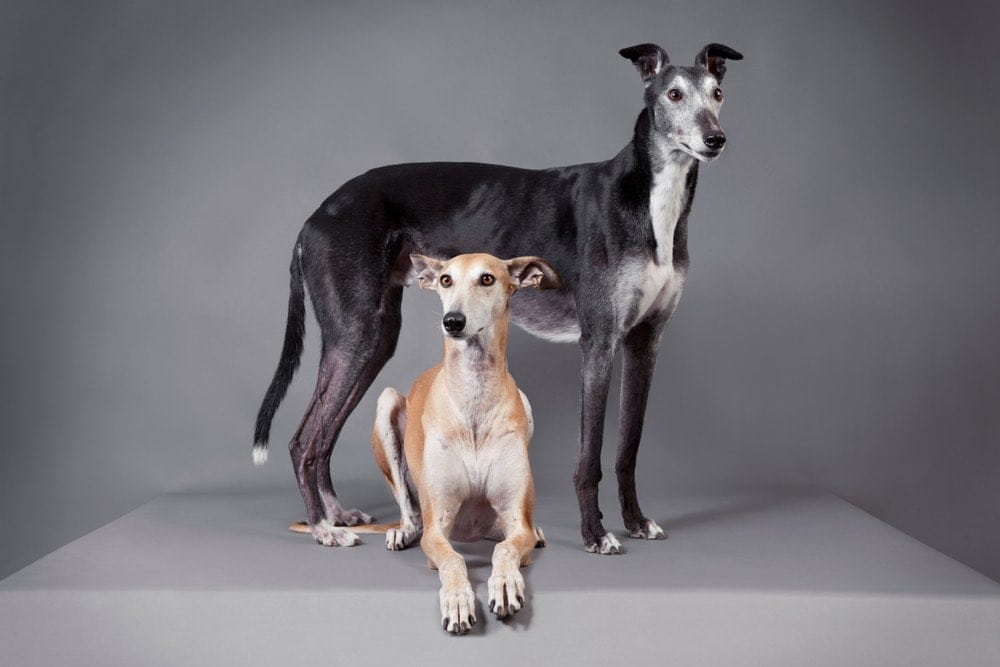
There are few other breeds as storied and historically rich as the Greyhound. Their lineage can be directly traced back to the time when Pharaohs ruled Ancient Egypt through hieroglyphic paintings. And they’re also the only dog breed that’s mentioned in the Bible!
These sighthounds were once great hunters throughout the Middle East and Northern Africa. Eventually, they made their way across the Mediterranean and found themselves in Central Europe before landing in the UK. When Spanish and British colonists first ventured to the New World, they brought Greyhounds along to help hunt down food and vermin.
In 1919, the very first successful Greyhound coursing track opened in Emeryville, California. And it was then that the breed officially made the jump from hunter to courser. Greyhound races are still popular to this day, although they’re becoming more and more controversial as the quality of care for racing Greyhounds is being questioned.
Personality
These dogs are some of the friendliest you’ll ever meet. When it’s not time to exercise or run, they’re actually extremely laid-back and patient. You’ll often see them lounging about and occupying a piece of prime sofa real estate.
Greyhounds also make for excellent family dogs as they are great with both older and younger children. They fare better with older children who know how to properly treat dogs. But they won’t snap at a younger child. If the child loses appeal, they’ll simply walk away and find somewhere else to be.
Similar to the Whippet, Greyhounds have huge prey drives—even greater than the former. This doesn’t mean they’ll go out and openly hunt your smaller pets, though. But they may give chase and injure them in a bout of rough play if you’re not careful.
Training
Like the Whippet, the Greyhound can be rather headstrong and stubborn. There’s a good chance they won’t respond to commands the first time they’re given, and you may find yourself repeating time and time again.
That doesn’t mean they’re not intelligent; they just need some extra dedication and positive reinforcement. Harsh training doesn’t suit them very well, as they are likely to become even more obstinate. Instead, use food rewards and treats when they properly complete a command. Also, they might have trouble with the sit command. And it’s not because they just can’t grasp the concept, but sitting is an unnatural position for them and can be difficult to physically position.

Health and Care
Greyhounds are generally considered to be very healthy dogs. Although there are a few conditions you should keep an eye out for. First, they are rather susceptible to bloat. This is when their stomach enlarges and twists into an unnatural position. To prevent this, you should regulate their playtime and activity after eating so a sufficient amount of time has passed to allow excess air to be absorbed by their bodies.
Greyhounds are also among the easiest dogs to groom. They have thin, light coats that don’t shed too much and don’t require frequent brushing. Their coats present the same problem as the Whippet’s, causing the Greyhound to scrape and scratch easier. They’ll also need special consideration in colder environments.
Whippet vs. Greyhound: Which Should You Choose?
When deciding between the Whippet and the Greyhound, there are three major points of comparison to consider.
Size
The biggest Whippet is still smaller than the tiniest Greyhound. So, if you’re looking for a bigger dog, the Greyhound could be a suitable companion. But if you’re living in an apartment or smaller space, consider the Whippet.
Another thing to consider when it comes to size is the amount of food each will need. The Greyhound will require more food than the Whippet. That can add up quickly, especially if you’re feeding them highly nutritious dog food.
Price
When comparing the price of a Whippet puppy and a Greyhound pup, there’s no question that the Whippet will be more wallet-friendly. A new Whippet puppy will run you somewhere between $800-$1,500. A Greyhound pup can easily fetch much more than $1,500, especially if buying through a champion racer’s line.
However, if you’re not opposed to adopting an older dog, a Greyhound may be the cheaper option. There are tons of charities and organizations dedicated to helping retired Greyhound racers find new forever homes at a low cost.
Energy Requirements
Although the Whippet requires an average amount of exercise each day, the Greyhound needs that extra physical activity. It’s in their blood to be movers and shakers. And if you don’t have the time and energy to dedicate to them, a Whippet could be a better choice for you.
But whichever breed you choose, you’ll be adopting a wonderfully marvelous family dog who’ll ask for nothing in return except for maybe some good loving and a place to crash on the sofa.
- Related Read: Whippet vs. Italian Greyhound: What’s the Difference?
Feature Image Credit: (L) tommaso lizzul, Shutterstock | (R) Tracy Kerestesh, Shutterstock

